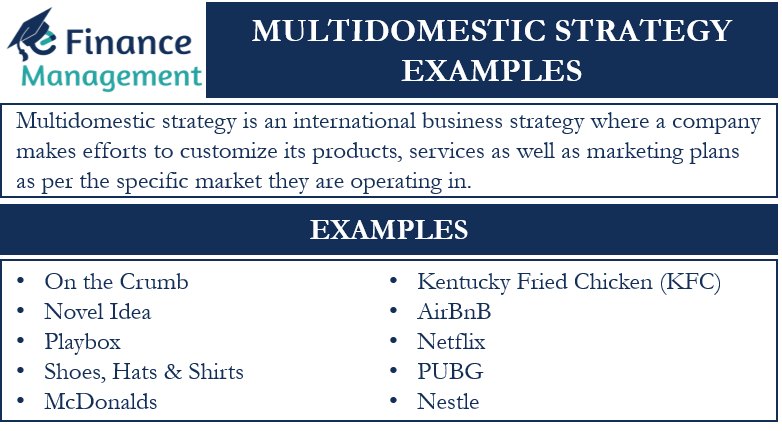Multidomestic strategy is an international business strategy where a company makes efforts to customize its products, services as well as marketing plans as per the specific market they are operating in. We can say that a company practicing a multidomestic strategy adjusts its marketing, packaging, and even product lines to meet local preferences. Sometimes companies also come up with a new brand for a specific market. Companies usually carry out in-depth research before customizing their products and services for a particular market. Let’s take a look at some real-life multidomestic strategy examples.
Multidomestic Strategy Examples
Following are some real-life examples of companies using multidomestic strategy:
On the Crumb
It is a U.S. takeout and delivery cookie company that wanted to expand into Canada. First, the company set up a localization team to carry out extensive research about local preferences and eating habits. Later, the company recruited a Canadian marketing agency, as well as employees speaking Canadian, French, and English.
The agency helped the company to come up with an advertising campaign and new product packaging to meet the preferences of Canadians, French, and English. Also, the company’s recipe development team developed a new cookie recipe to meet the taste of the local market.
Novel Idea
It is a UK-based literary magazine that does book reviews, interviews of authors and publishers, etc. The company wanted to expand into France and Spain, and for this, created two localization teams. Each team undertook extensive research on the country they were allotted, including authors, publishing houses, publishing markets, and more.
After the research, the UK company hired a French and a Spanish marketing team. The responsibilities of the teams were to work with the local editors, reviewers, photographers, and writers. Later the company set up an office, printing house, and distribution center in each country, and started issuing local versions of its magazines.

Playbox
It is a U.S. board game company that wanted to expand into Mexico. Playbox’s localization team first carried out research on the Mexican culture, religious traditions, board game habits, and more. After this, the company partnered with a Mexican marketing agency, as well as with a team of localizers. It allowed the company to customize many of its games for local audiences. Also, the company invented two new board games for the new markets. These games had localized branding, packaging, and design.
Shoes, Hats & Shirts
It is a U.S. clothing company with a focus on teens. For its international expansion, the company adjusts its styles and sizes to meet the preferences and body types of the new country.
McDonald’s and Kentucky Fried Chicken (KFC)
We can call McDonald’s the biggest example of a company practicing a multidomestic strategy. For instance, McDonald’s Indian doesn’t offer any beef and pork items in India. Also, the company re-engineered its operations to meet the expectations of the vegetarian audience in India, including separate veg and non-veg kitchen, the use of vegetable oil only, and the use of 100% cheese and cold sauces.
KFC also did something similar to achieve success in international markets, especially in India and China.
AirBnB
AirBnB has a presence in over 200 countries and is able to disrupt the hospitality industry in each country with its multidomestic strategy only. The company believes in giving a personal touch to every interaction. Their website and app are available in 62 different languages. To add to the authenticity, the company translates all user-generated content on its site, including listing details and reviews, into the local language.
Netflix
This streaming company invests heavily in developing content for local audiences. Netflix has come up with technology and processes that translate not only its apps and interfaces but also the subtitles and voice dubbing.
PUBG
It is one of the most popular games globally. One major reason for the success of the game worldwide is the use of a multidomestic strategy. The game is available in 11 different languages, allowing players to better understand the instructions and other game content. Moreover, the game developer also customized the game for a few countries. In China, for instance, game developer tone down violence following concerns from the Chinese government.
Nestle
This Swiss conglomerate owns several brands and operates in more than 186 countries. In each country, Nestle offers a selection of brands to match local preferences.
It won’t be wrong to say that most multinational companies use a multidomestic strategy to achieve success in the international markets. Johnson & Johnson, Apple, Coca-Cola, Procter & Gamble, and Frito-Lay, are a few more names that use the multidomestic strategy.
RELATED POSTS
- International Market – Lucrative But Challenging As Well
- Advantages and Disadvantages of International Business
- Concentric Diversification – Meaning, Advantages, and More
- Advantages and Disadvantages of Differentiation Strategy
- International Business – Issues and Challenges
- Ansoff Matrix – Meaning, Strategies, Steps and Examples

